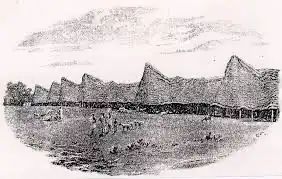Sack of Old Oyo
| Abandonment of Oyo-Ile | |||||||||
|---|---|---|---|---|---|---|---|---|---|
| Part of the Yoruba Wars | |||||||||
 Katunga in the 19th century | |||||||||
| |||||||||
| Belligerents | |||||||||
|
Ogodo Ilorin Emirate | Oyo Empire | ||||||||
The Fall or Sack of Old Oyo refers to the abandonment and subsequent destruction of Oyo-Ile, the capital and largest city of the Oyo Empire, in the mid-1830s during the Yoruba Wars.[1][2]
Background
The Oyo Empire, once the most powerful state in the region, had weakened dramatically at the expense of the rising Ilorin Emirate.[3][4] Oluewu, Alaafin of Oyo, tried to restore his dynasty's prestige, but was defeated and killed at the Battle of Ilorin.[5][3]
Abandonment
During the Alaafin's absence Lanloke, chief of Ogodo, had attacked the city but been repulsed. When news of the disaster outside Ilorin arrived, he attacked again but was again unsuccessful. The citizens of the city, however, understood that they could not hold out.[6] Nearly all of them packed their bags and fled the city, leaving it abandoned.[7] The Oyo royal family and many nobles fled southward to establish a new capital at Oyo Atiba (New Oyo).[8] Other refugees went to Kihisi, Igboho or even Ilorin. Some were able to make multiple return trips to the city to collect their belongings. Eventually Lanloke returned a third time, plundered what little wealth remained, and left the city in ruins.[6]
Aftermath
Ilorin gained control of former Oyo territories in the north.[9]
References
- ^ "Oyo | Nigeria, Map, History, & Population | Britannica". www.britannica.com. Retrieved 2025-07-04.
- ^ Bascom, William (1959). "La Chute De L'ancien Oyo Ou De Katunga". Presence Africaine (24/25): 299–304. ISSN 0032-7638. JSTOR 24349019.
- ^ a b Ogundiran 2020, p. 382.
- ^ Akintoye 2014, p. 284-6.
- ^ Akintoye 2014, p. 293.
- ^ a b Johnson, Samuel (2001) [1921]. The history of the Yorubas : from the earliest times to the beginning of the British Protectorate. Internet Archive. Lagos, Nigeria: CMS Bookshops. p. 268. ISBN 978-978-2951-82-3.
- ^ Akintoye 2014, p. 294.
- ^ Usman, Aribidesi (2024-08-21), "Warfare among Yoruba in the Nineteenth Century", Oxford Research Encyclopedia of African History, doi:10.1093/acrefore/9780190277734.001.0001/acrefore-9780190277734-e-277?d=/10.1093/acrefore/9780190277734.001.0001/acrefore-9780190277734-e-277&p=emaila0qrjp4igzbyy (inactive 1 July 2025), ISBN 978-0-19-027773-4, retrieved 2025-04-06
{{citation}}: CS1 maint: DOI inactive as of July 2025 (link) - ^ Lockhart, Jamie Bruce; Lovejoy, Paul E., eds. (2005-01-01), "Residence at Eyeo-Ile or Katunga, the capital of the Youriba", Hugh Clapperton into the Interior of Africa, Brill, pp. 143–166, ISBN 978-90-474-0660-0, retrieved 2025-07-04
Sources
- Akintoye, S. Adebanji (2014). A History of the Yoruba People. Dakar: Amalion.
- Ogundiran, Akinwumi (2020). The Yoruba: A New History. Indiana University Press. ISBN 9780253051509.